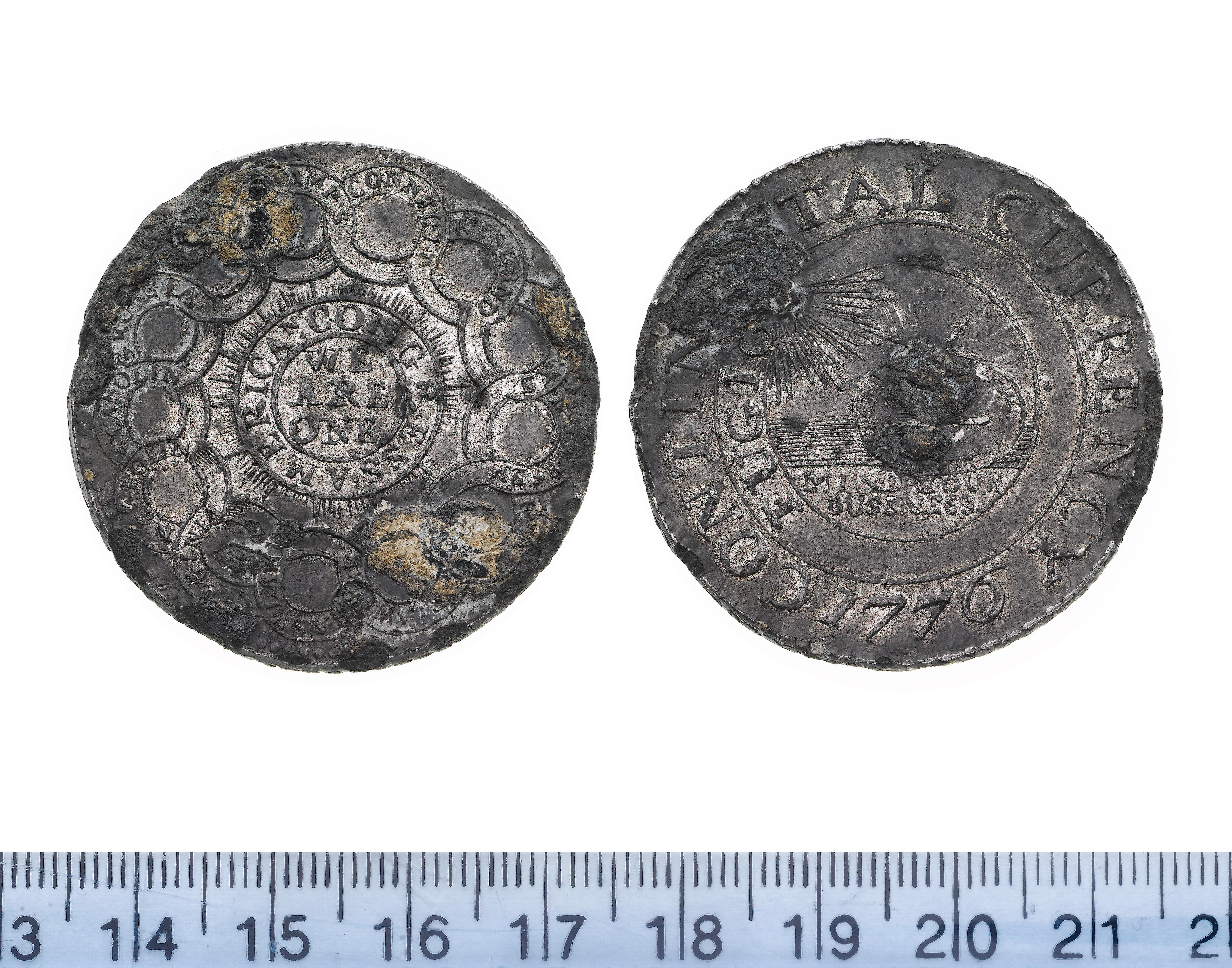Continental Currency, Dollar, 1776, in pewter, e g fecit, 18.76g/2h (Newman 3-D; Breen 1095; Durst 320). Virtually as struck, most attractive (£20,000-25,000) Footnote Provenance: From an old British Collection, brought back from the USA before 1800. Illustrated on the front cover. The first issue of Continental paper currency was authorized on 22 June 1775. The notes were paid out in large quantities without any backing in specie and could only be redeemed at some future date, dependant on America gaining independence. By the Spring of 1776 the growing distress of the colonists about a lack of ready coin resulted in appeals for the establishment of a mint, but Congress declined and no written evidence exists to prove that a mint was set up in that year. Nevertheless, it has been suggested that the coins, the designs of which are derived from that on the paper money in the Congress authority of 17 February 1776, were almost certainly struck some time after the suspension of the $1 note on 22 July 1776 – perhaps in October of that year. Certainly, from a letter published in the London Chronicle of Christmas Eve, 1776, knowledge of the new Continental dollars had reached England from a correspondent based with the 64th Regiment of Foot in what is now Manhattan. The letter mentions the establishment of a new mint at Philadelphia, first described in a Congress resolution of 20 February 1777. Some of the coins are signed e g fecit, almost certainly Elisha Gallaudet (c. 1730-1805), the New Jersey artist who also engraved the vignettes used for the Continental paper currency. It is thought that Benjamin Franklin had originally suggested the distinctive designs, particularly the linked rings on the reverse, a plea for insurgent unity. Most of the extant specimens are in pewter, probably as an emergency measure because the lack of available bullion prevented a silver coinage, but even this would have made a desirable alternative for unsecured Continental paper, which in any case was rapidly losing its value with the onset of the chain of military disasters suffered by Washington’s troops in late 1776. By late 1777, the prestige of Congress and the value of its paper currency were nearly gone and the concept of a metallic Continental coinage receded like a mirage
Continental Currency, Dollar, 1776, in pewter, e g fecit, 18.76g/2h (Newman 3-D; Breen 1095; Durst 320). Virtually as struck, most attractive (£20,000-25,000) Footnote Provenance: From an old British Collection, brought back from the USA before 1800. Illustrated on the front cover. The first issue of Continental paper currency was authorized on 22 June 1775. The notes were paid out in large quantities without any backing in specie and could only be redeemed at some future date, dependant on America gaining independence. By the Spring of 1776 the growing distress of the colonists about a lack of ready coin resulted in appeals for the establishment of a mint, but Congress declined and no written evidence exists to prove that a mint was set up in that year. Nevertheless, it has been suggested that the coins, the designs of which are derived from that on the paper money in the Congress authority of 17 February 1776, were almost certainly struck some time after the suspension of the $1 note on 22 July 1776 – perhaps in October of that year. Certainly, from a letter published in the London Chronicle of Christmas Eve, 1776, knowledge of the new Continental dollars had reached England from a correspondent based with the 64th Regiment of Foot in what is now Manhattan. The letter mentions the establishment of a new mint at Philadelphia, first described in a Congress resolution of 20 February 1777. Some of the coins are signed e g fecit, almost certainly Elisha Gallaudet (c. 1730-1805), the New Jersey artist who also engraved the vignettes used for the Continental paper currency. It is thought that Benjamin Franklin had originally suggested the distinctive designs, particularly the linked rings on the reverse, a plea for insurgent unity. Most of the extant specimens are in pewter, probably as an emergency measure because the lack of available bullion prevented a silver coinage, but even this would have made a desirable alternative for unsecured Continental paper, which in any case was rapidly losing its value with the onset of the chain of military disasters suffered by Washington’s troops in late 1776. By late 1777, the prestige of Congress and the value of its paper currency were nearly gone and the concept of a metallic Continental coinage receded like a mirage















Try LotSearch and its premium features for 7 days - without any costs!
Be notified automatically about new items in upcoming auctions.
Create an alert